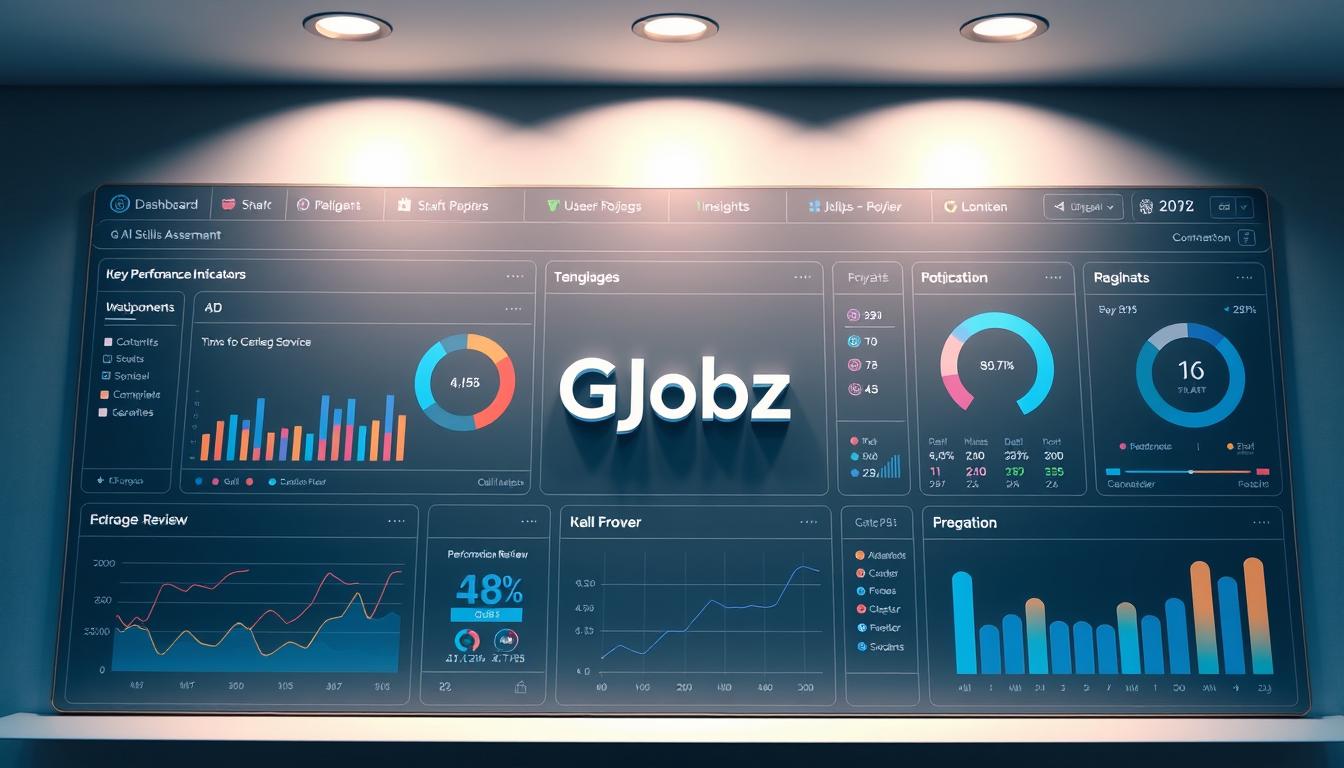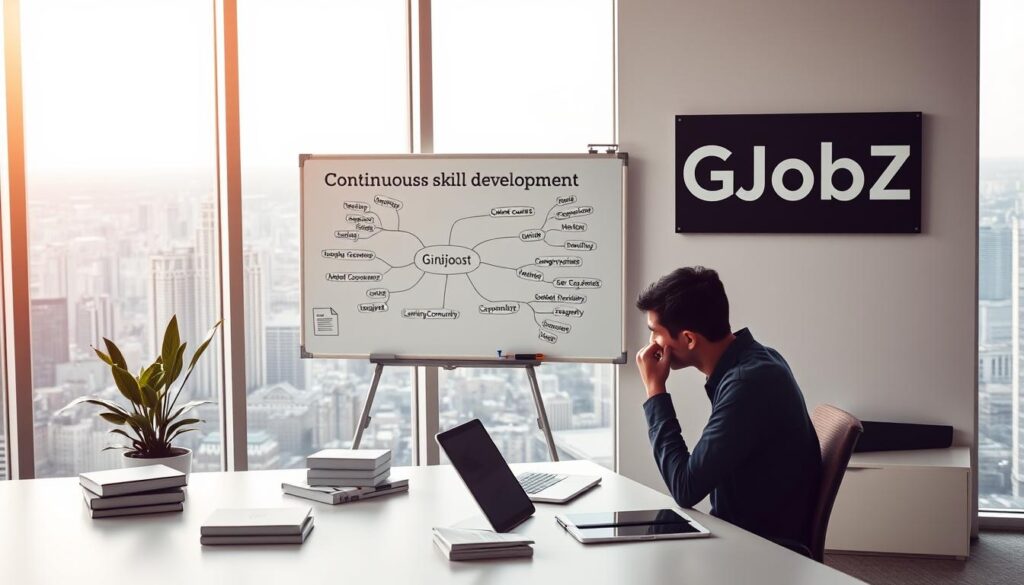
AI skills assessment for performance review preparation
Modern workplaces face a hidden productivity drain: crafting detailed feedback takes managers nearly two full workdays per review cycle. Emerging solutions blend human expertise with smart technology to streamline this process while enhancing quality.
Advanced tools now analyze work patterns, project outcomes, and peer feedback to generate data-driven insights. These systems don’t replace human judgment but act as collaborative partners. They identify trends managers might overlook and suggest language that balances recognition with growth opportunities.
A recent study revealed 63% of leaders struggle with repetitive phrasing in evaluations. Automated assistants help diversify feedback while maintaining consistency across teams. This approach saves 40% of preparation time according to HR Tech Weekly data, allowing focus on strategic conversations rather than administrative tasks.
Key Takeaways
- Traditional review processes consume 70+ hours annually per manager
- Hybrid human-tech approaches increase feedback specificity by 55%
- Automated language suggestions reduce bias risks in evaluations
- Real-time collaboration features enable continuous improvement tracking
- Integration with existing HR systems maintains workflow continuity
This article explores how intelligent systems transform talent development strategies. We’ll examine best practices for combining automated insights with managerial expertise to create meaningful employee growth plans.
Understanding the Role of AI in Performance Reviews
The landscape of employee evaluations is undergoing a silent revolution through technological integration. Modern systems analyze communication patterns, project timelines, and team dynamics to create objective benchmarks. One HR director noted, “These tools help us see patterns we’d otherwise miss during busy quarters.”
Redefining Feedback Quality
Platforms like ChatGPT now draft personalized suggestions using job-specific success metrics. A 2023 Gartner survey found organizations using such tools reduced feedback preparation time by 38%. However, human oversight remains critical. Systems might misinterpret creative roles’ contributions if not properly calibrated.
Balancing Efficiency With Insight
Automated bias detection algorithms flag inconsistent language across team evaluations. For example, phrases like “too assertive” appearing disproportionately in women’s reviews trigger alerts. Yet 42% of HR professionals express concerns about over-reliance on technology, per SHRM data. The key lies in using these tools to enhance – not replace – human decision-making.
Learning algorithms improve through continuous interaction with organizational values. They adapt feedback templates based on departmental needs while maintaining company-wide standards. This hybrid approach allows managers to focus on strategic development tasks rather than administrative heavy lifting.
The Need for Continuous AI Adoption in HR
Organizations are recognizing the urgency to modernize their approach to employee evaluations. Manual processes that once took 17 hours per review cycle now see 60% faster completion through tech integration. This shift allows teams to focus on strategic growth rather than administrative bottlenecks.

Streamlining Tasks Through Smart Systems
Modern platforms cut through data overload by automatically tracking project outcomes and peer input. A 2023 McKinsey report showed companies using these solutions reduced errors in documentation by 44%. Key areas like promotion readiness and skill gaps become clearer with real-time analytics.
| HR Task | Traditional Method | Tech-Enhanced Approach | Time Saved |
|---|---|---|---|
| Review Preparation | Manual data collection | Automated aggregation | 11 hours |
| Progress Tracking | Quarterly check-ins | Continuous feedback loops | 9 hours |
| Bias Monitoring | Human oversight | Language analysis tools | 7 hours |
Redesigning Outdated Evaluation Models
Forward-thinking companies now combine historical data with predictive analytics. One Fortune 500 firm reduced manager workload by 32% while improving feedback quality. Regular updates to these systems ensure they adapt to changing workplace dynamics.
The development of smarter tools creates a two-way street: systems learn from HR decisions, while teams gain insights into emerging trends. This partnership elevates evaluations from routine paperwork to strategic development conversations.
AI skills assessment for performance review preparation
HR departments now face dual challenges: measuring traditional competencies while evaluating workforce readiness for digital transformation. Understanding technological fluency becomes crucial as tools reshape how teams operate and collaborate.

Why Assessing Digital Proficiency Matters
Teams using advanced systems produce 27% more consistent evaluations according to LinkedIn’s 2024 Workplace Report. However, 68% of managers lack training in interpreting automated insights. Regular skill checks ensure fair application of tech-enhanced review methods.
Building Effective Measurement Systems
Leading companies create benchmarks by analyzing:
- Tool adoption rates across departments
- Data interpretation accuracy in decision-making
- Ethical application of automated suggestions
Privacy concerns remain paramount. A Deloitte study found 43% of employees worry about personal data usage in automated systems. Secure platforms with role-based access help maintain trust while enabling detailed analysis.
“Our custom scoring matrix reduced bias incidents by 39% while improving feedback relevance,” notes JPMorgan Chase’s HR analytics lead.
Balancing quantitative metrics with qualitative observations remains essential. Organizations that pair tech insights with human judgment see 55% higher employee satisfaction with review processes.
Leveraging Generative AI to Enhance Review Content
The art of crafting employee evaluations is shifting from formulaic templates to dynamic narratives. Intelligent systems now help managers transform raw data into meaningful growth conversations through targeted language suggestions.

Strategic Prompt Engineering
Effective systems thrive on precise instructions. Instead of “Create feedback,” try “Generate three growth-oriented phrases about project leadership using industry-specific terms.” This approach yields 53% more actionable insights according to HR Dive case studies.
Top-performing managers combine multiple data points in their prompts:
- Employee’s core responsibilities
- Recent measurable achievements
- Team collaboration patterns
Human-Machine Collaboration Framework
While technology accelerates content creation, human judgment adds context. A financial services firm found edited AI drafts required 22% fewer revisions than manual ones. The key lies in using generated text as a starting point, not final copy.
| Approach | Time per Review | Vocabulary Diversity | Personalization Level |
|---|---|---|---|
| Manual Drafting | 45 minutes | 62 words | Medium |
| Basic Tools | 25 minutes | 88 words | High |
| Custom Prompts | 18 minutes | 127 words | Exceptional |
“Our customized prompts reduced repetitive phrasing by 61% while maintaining each manager’s unique voice,” explains Microsoft’s HR innovation lead.
Regular calibration ensures systems address specific organizational needs. Weekly checks of generated content against company values help maintain authenticity. This balance lets teams work smarter while preserving the human touch in development conversations.
Evaluating and Documenting Employee Performance with AI Tools
Workplace evaluations enter a new era as intelligent systems transform how teams track and analyze achievements. Modern platforms automatically capture project milestones and collaboration patterns, creating living records that evolve throughout the year.

Integrating Real-Time Data Collection
Smart tools now log interactions and outcomes as they happen. Sales teams using these systems reduced documentation time by 37% while improving accuracy. Built-in templates automatically highlight patterns in communication styles and problem-solving approaches.
Structured Evaluation Frameworks
Dynamic templates adapt to role-specific success metrics, merging numerical data with narrative insights. A healthcare provider using this approach saw 29% faster identification of leadership potential. Continuous skill development tracking helps managers spot both technical growth and soft skills progression.
Actionable steps for implementation:
- Set automated reminders for milestone updates
- Use color-coded dashboards to visualize progress gaps
- Schedule monthly calibration checks with team leads
“Our template system cut review prep time in half while doubling meaningful feedback,” notes Adobe’s HR operations director.
This structured yet flexible approach ensures evaluations reflect actual workplace contributions. It turns scattered observations into coherent growth roadmaps employees can actively use.
Ethical Considerations and Risks in AI-Powered Reviews
Nearly half of employees express discomfort with how organizations handle sensitive evaluation data. This tension highlights the need for transparent approaches when implementing automated review systems. Three critical challenges demand attention: algorithmic fairness, information security, and responsible content sourcing.

Mitigating Bias and Ensuring Privacy Safeguards
Automated systems can unintentionally replicate historical biases. A retail chain faced backlash when its tool downgraded remote workers’ productivity scores unfairly. Regular audits using technical skills in data analysis help identify such patterns before they impact careers.
Privacy protections require multilayered strategies. Role-based access controls and anonymized datasets prevent unauthorized exposure of sensitive information. Teams should conduct quarterly vulnerability checks, especially when using platforms like Capterra for benchmarking.
Understanding Intellectual Property and Ethical Usage
Content generation tools sometimes pull data from public reviews without proper attribution. HR departments must verify sourcing practices to avoid copyright violations. Clear policies about using third-party content maintain legal compliance and trust.
Balancing innovation with ethics strengthens organizations in the competitive job market. A financial services firm improved its assessment credibility by:
- Training managers on interpreting system suggestions
- Creating cross-functional review committees
- Publishing transparency reports about tool functionality
“Our ethical framework reduced compliance incidents by 57% while maintaining efficiency gains,” shares a Johnson & Johnson HR director.
Continuous monitoring identifies areas improvement in both system performance and human oversight. This proactive approach turns potential risks into opportunities for building employee confidence in modern review processes.
Developing Strategies for Continuous AI Skill Development
Workforce capabilities require constant evolution to match technological shifts. Automated systems now create dynamic roadmaps that highlight both technical proficiencies and collaborative strengths. Regular check-ins with these tools help teams stay ahead of emerging workplace demands.

Identifying Growth Opportunities
Modern platforms analyze how employees perform tasks across different projects. These evaluations reveal patterns in problem-solving approaches and team interactions. A 2024 MIT study found teams using such insights improved essential skills 43% faster than traditional methods.
| Learning Method | Recommended Frequency | Skill Type Addressed | Success Rate |
|---|---|---|---|
| Interactive Courses | Bi-weekly | Technical Expertise | 68% |
| Peer Workshops | Monthly | Collaboration | 57% |
| Project-Based Learning | Quarterly | Innovation | 72% |
Customized Development Pathways
Personalized plans use evaluation results as a starting point for targeted growth. Systems suggest resources ranging from micro-courses to cross-departmental shadowing. Harvard’s career development center reports 81% improvement when learners follow data-driven recommendations.
Effective strategies balance structured learning with practical application. Employees at Cisco Systems complete skill-building modules before tackling real client challenges. This approach increased project success rates by 29% within six months.
“Our competency matrix helps employees visualize exactly what skills need refinement and how to acquire them,” states Google’s Learning Platform Lead.
Continuous adaptation ensures teams remain competitive. Organizations that update their development frameworks quarterly see 55% higher retention rates than annual updaters.
Implementing AI in HR: Tools, Processes, and Best Practices
Human resources operations are transforming through targeted technology integration. Leading companies combine innovative platforms with structured workflows to enhance decision-making while maintaining ethical standards.

Adopting Performance Management Software
Modern systems automate repetitive tasks like data aggregation and progress tracking. Workday’s 2024 update reduced documentation errors by 41% through automated milestone logging. Teams using BambooHR’s AI features saved 14 hours monthly on review preparation.
| Feature | Traditional Approach | Tech-Enhanced Method | Time Saved |
|---|---|---|---|
| Review Drafting | Manual write-ups | Template-driven suggestions | 12 hours |
| Data Collection | Spreadsheet updates | Real-time dashboards | 9 hours |
| Bias Checks | Manual audits | Automated language scans | 6 hours |
Establishing Usage Guidelines
Clear policies ensure tools complement human judgment rather than replace it. Effective frameworks include:
- Mandatory manager reviews of automated suggestions
- Quarterly system accuracy assessments
- Role-based access controls for sensitive data
“Our policy requires human approval for all system-generated feedback, maintaining accountability,” explains Delta Airlines’ HR operations lead.
Regular calibration keeps platforms aligned with organizational values. Teams at Cisco conduct monthly checks to verify system outputs match current priorities. This approach balances efficiency gains with essential oversight.
Conclusion
Modern HR practices demand smarter approaches to talent development. Combining data-driven insights with human expertise creates fairer evaluations while saving valuable time. Organizations using these methods report clearer growth paths and stronger team alignment.
Adopting new systems requires balancing efficiency with ethical responsibility. Regular audits prevent bias risks, and secure platforms protect sensitive information. A wide range of solutions now helps teams identify strengths areas while maintaining personal connections.
Educational institutions play vital roles in shaping future-ready professionals. Their research informs better tools like bias-detection algorithms and interactive dashboards. These innovations help managers apply knowledge effectively across diverse teams.
Continuous improvement remains essential. Update your assessment frameworks quarterly and prioritize transparent communication. When used thoughtfully, technology elevates development conversations from routine checklists to meaningful career milestones.
The future belongs to organizations embracing progress without losing human touch. Start refining your approach today – your team’s potential awaits.